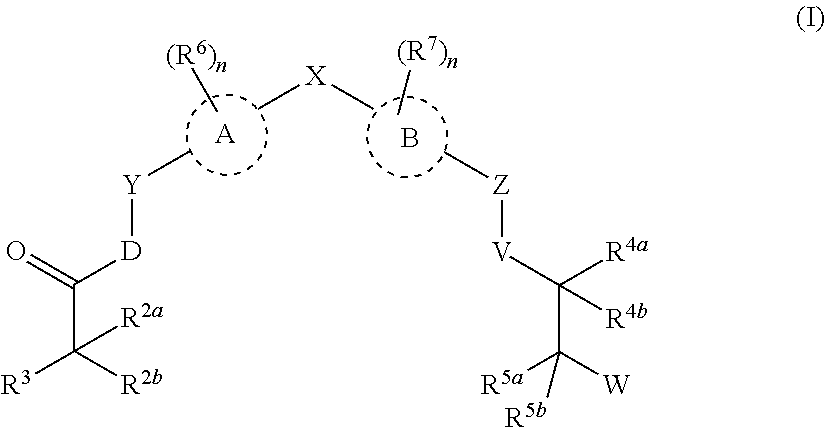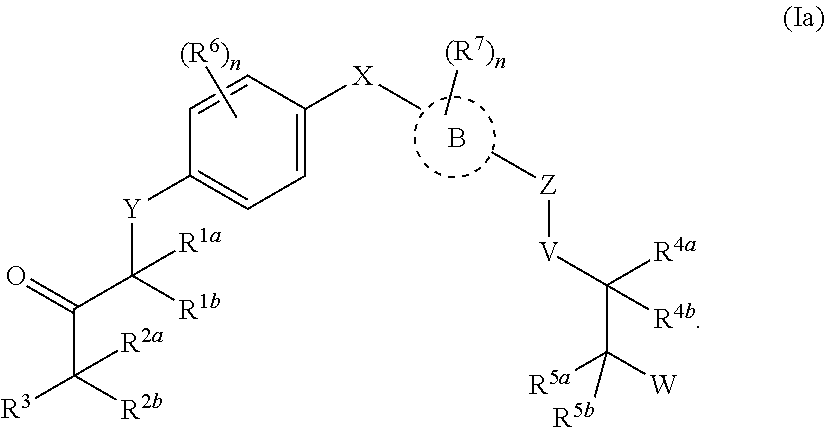Androgen receptor modulators and methods for their use
a technology of androgen receptors and modulators, applied in the field of bisphenol related compounds, can solve the problem that prostate cancer can eventually grow
- Summary
- Abstract
- Description
- Claims
- Application Information
AI Technical Summary
Benefits of technology
Problems solved by technology
Method used
Image
Examples
example 1
on of Exemplary Compounds of the Disclosure
[0800]The novel compounds of the present disclosure can be prepared in a variety of ways known to one skilled in the art of organic synthesis. The compounds of the present disclosure can be synthesized using the methods as hereinafter described below, together with synthetic methods known in the art of synthetic organic chemistry or variations thereon as appreciated by those skilled in the art.
[0801]Preparation of compounds can involve the protection and deprotection of various chemical groups. The need for protection and deprotection, and the selection of appropriate protecting groups can be readily determined by one skilled in the art. The chemistry of protecting groups can be found, for example, in Greene and Wuts, Protective Groups in Organic Synthesis, 44th. Ed., Wiley & Sons, 2006, as well as in Jerry March, Advanced Organic Chemistry, 4th edition, John Wiley & Sons, publisher, New York, 1992 which are incorporated herein by reference...
example 1-01
(2-(3,5-dichloro-4-(3-chloro-2-hydroxypropoxy)phenyl) propan-2-yl)phenoxy)-2-oxopropyl)methanesulfonamide (A51(S))
[0825]
[0826]Steps a: Synthesis of 4-(2-(4-(trityloxy)phenyl)propan-2-yl)phenol. 4,4′-(Propane-2,2-diyl)diphenol (1a) (5.0 g, 1.0 eq) and DMAP (0.027 g, 0.01 eq) were dissolved in DCM (60 mL, 12 vol). Triethylamine (3.05 mL, 1.0 eq) was added and the reaction was cooled to 0-5° C. A solution of trityl chloride (4.89 g, 0.8 eq) in DCM (10 mL, 2 vol) was added dropwise. The reaction was continued at 0-5° C. for 80 min and the room temperature for 16 hours. The slurry was diluted with DCM and water. The organic layer was separated and diluted with equal volume of heptane. The solid was filtered off. The filtrate was concentrated to dryness and purified by flash chromatography using EtOAc / heptane to give 4-(2-(4-(trityloxy)phenyl)propan-2-yl)phenol (1b) (6.1 g, 59% yield) as colorless thick syrup. HPLC purity (96%). LRMS (M+H+) m / z: calcd 229.12; found 229.
[0827]Steps b: Synt...
example 1-02
3,5-dichloro-4-(3-chloropropoxy)phenyl)propan-2-yl)phenoxy)-2-oxopropyl)methanesulfonamide (A31)
[0834]
[0835]Step a: Synthesis of (S)-3-(4-(2-(3,5-dichloro-4-((S)-3-chloro-2-hydroxypropoxy)phenyl)propan-2-yl)phenoxy)-2-hydroxypropyl 4-methylbenzenesulfonate. A solution of 1-bromo-3-chloropropane (26 mg, 0.165 mmol, 1.5 eq.) in anhydrous DMF (1 mL) was added to a stirred solution of (R)—N-(3-(4-(2-(3,5-dichloro-4-hydroxyphenyl)propan-2-yl)phenoxy)-2-hydroxypropyl)methanesulfonamide (le) (50 mg, 0.11 mmol, 1.0 eq.) and potassium carbonate (23 mg, 0.165 mmol, 1.5 eq.) in anhydrous DMF (3 mL) at room temperature. and the reaction were stirred under an atmosphere of argon for 16 hours. The reaction was quenched by the addition of a saturated solution of ammonium chloride (1 mL), and the solution was extracted with ethyl acetate (60 mL). The organic layer was washed with deionized water (2×30 mL), dried over anhydrous magnesium sulfate, filtered, and concentrated under reduced pressure. Th...
PUM
 Login to View More
Login to View More Abstract
Description
Claims
Application Information
 Login to View More
Login to View More - R&D
- Intellectual Property
- Life Sciences
- Materials
- Tech Scout
- Unparalleled Data Quality
- Higher Quality Content
- 60% Fewer Hallucinations
Browse by: Latest US Patents, China's latest patents, Technical Efficacy Thesaurus, Application Domain, Technology Topic, Popular Technical Reports.
© 2025 PatSnap. All rights reserved.Legal|Privacy policy|Modern Slavery Act Transparency Statement|Sitemap|About US| Contact US: help@patsnap.com



